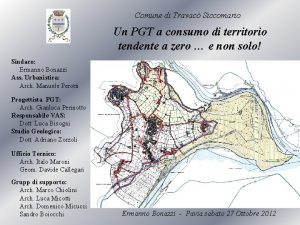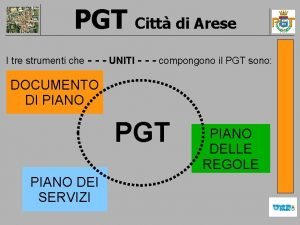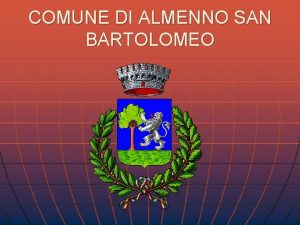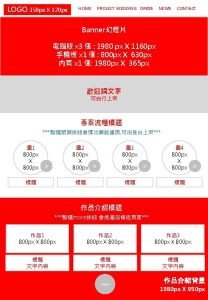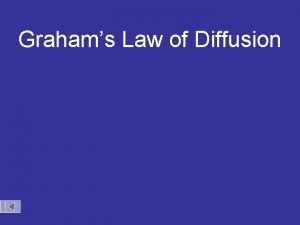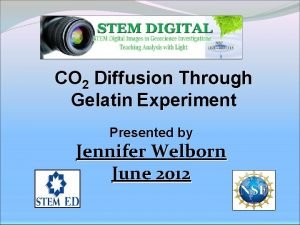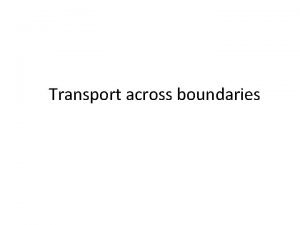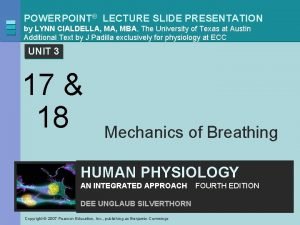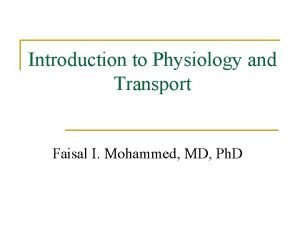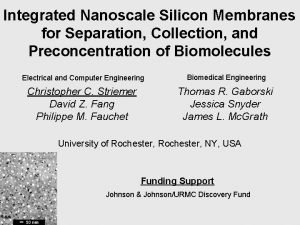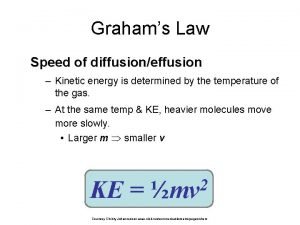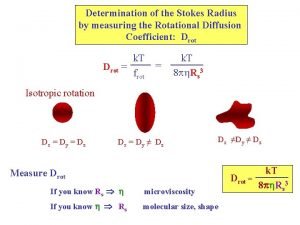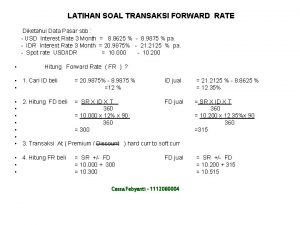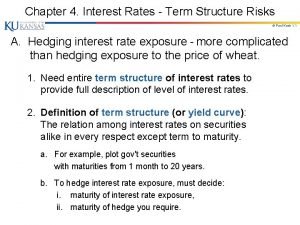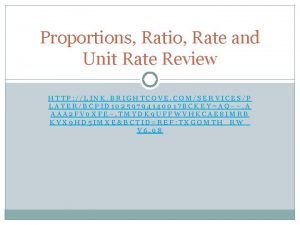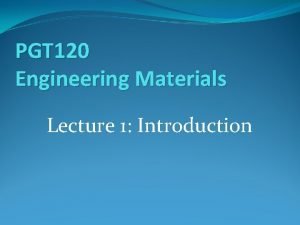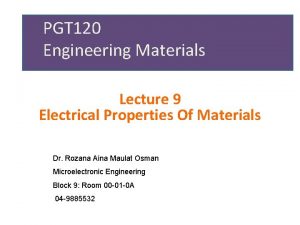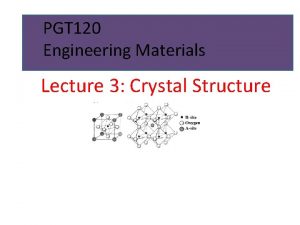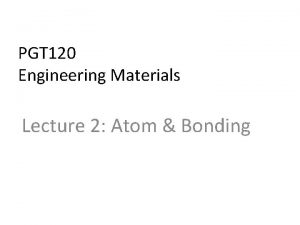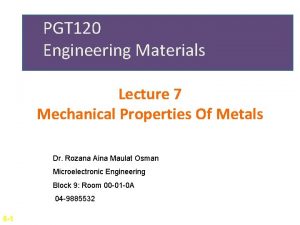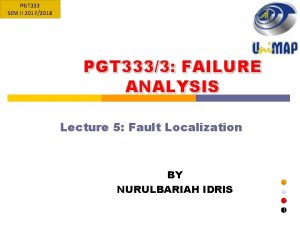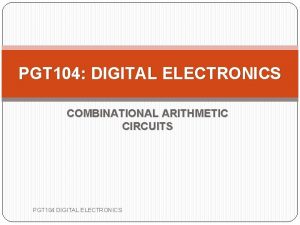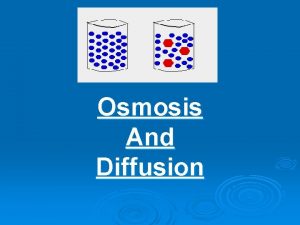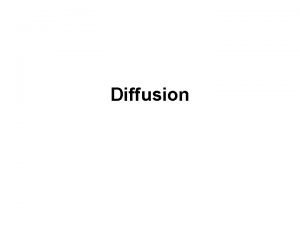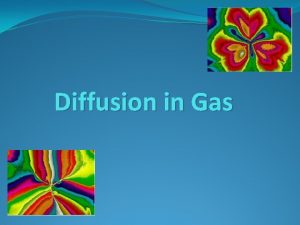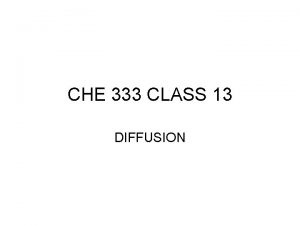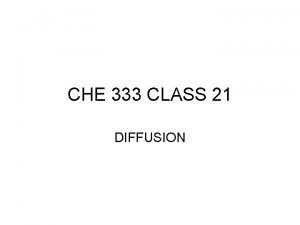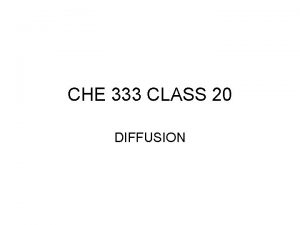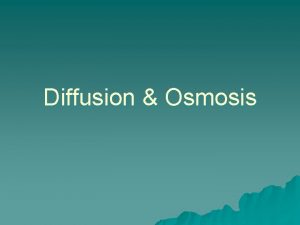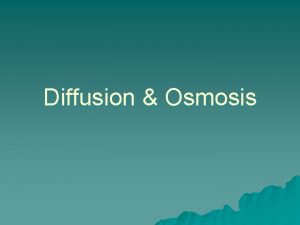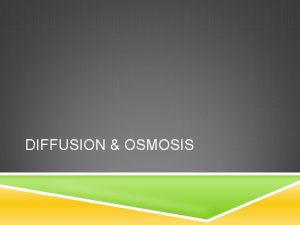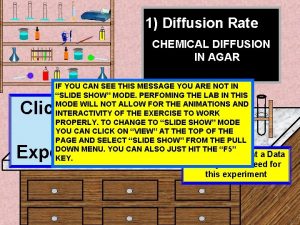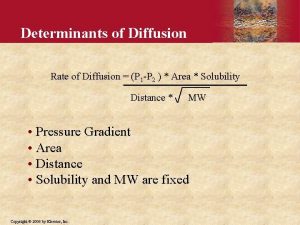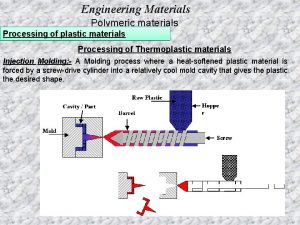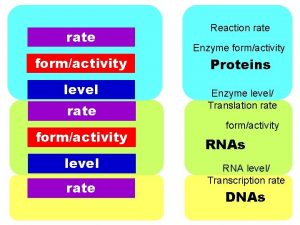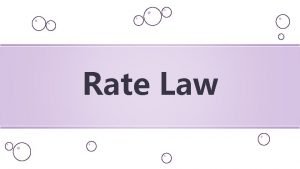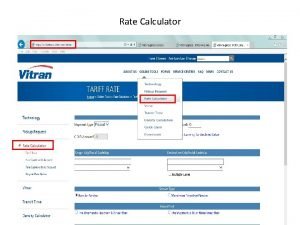PGT 120 Engineering Materials Lecture 6 Diffusion Rate



































- Slides: 35

PGT 120 Engineering Materials Lecture 6: Diffusion

Rate Process in Solids • Reactions occur in solid state resulting in more stable atomic arrangement. • Reacting atoms must have sufficient energy to overcome activation energy barrier. • At a given temperature, not all atoms have activation energy E*. It should be supplied to them. E* Activation Energy Er Reactants EP Reaction Coordinate 4 -34 Energy released Due to reaction Products Er = Energy of reactants E* = Activation Energy Level ΔE* = Activation Energy Ep = Energy of Products

Rate Process in Solids (Cont. . ) • As temperature increases, more and more atoms acquire activation energy level. • Probability of finding an atom/molecule with energy E* greater than average energy E of all atoms/ molecules is given by K = Boltzman’s Constant = 1. 38 x 10 -23 J/(atom. K). T = Temperature in Kelvin. 4 -35

Rate Process in Solids (Cont. . ) • The fraction of atoms having energies greater than E* in a system (when E* is greater than average energy E) is given by n = Number of molecules greater than energy E* Ntotal = Total number of molecules K = Boltzman’s Constant C = Constant T = Temperature in Kelvin. 4 -36

Rate Process in Solids (Cont. . ) • The number of vacancies at equilibrium at a particular temperature in a metallic crystal lattice is given by nv = Number of vacancies per m 3 of metal Ev = Activation Energy to form a vacancy T = Absolute Temperature. K = Boltznam, s Constant. C = Constant 4 -37

• Calculate (a) the equilibrium number of vacancies per cubic meter in pure copper at 500 degree Celsius and (b) the vacancy fraction at 500 degree Celsius. Assume the energy of formation of a vacancy in pure copper is 0. 90 e. V. Given C=1, k=8. 62 X 10 -5 e. V/K, density of copper=8. 96 Mg/m 3, atomic mass for copper=63. 54 g.


Arrhenius Equation • The rate of chemical reaction is given by Arrhenius equation. Rate of reaction = Ce-Q/RT Q = Activation energy J/mol R = Molar gas constant J/mol. K T = Temperature in Kelvin C = Rate constant (Independent of temperature) • Rate of reaction depends upon number of reacting molecules. 4 -38

Solidification of Metals • Arrhenius equation can also be written as ln (rate) = ln ( C) – Q/RT Or Log 10 (rate) = Log 10 (C) – Q/2. 303 RT Which is similar to Y = b + m X Which is equation of a straight line With Y intercept as ‘b’ and slope ‘m’. Y X b m Log 10(rate) (1/T) Log 10(C) Q/2. 303 R Figure 4. 34 4 -39 Arrhenius plot (After J. Wulff et al. , “Structure and Properties of Materials, ” vol. II: “Thermodynamics of Structure, ” Wiley, 1964, p. 64. )

Atomic Diffusion in Solids • Diffusion is a process by which a matter is transported through another matter. • Examples: Ø Movement of smoke particles in air : Very fast. Ø Movement of dye in water : Relatively slow. Ø Solid state reactions : Very restricted movement due to bonding. 5 -2

Vacancy or Substitutional Diffusion mechanism • Atoms diffuse in solids if Ø Vacancies or other crystal defects are present Ø There is enough activation energy • Atoms move into the vacancies present. • More vacancies are created at higher temperature. • Diffusion rate is higher at high temperatures. 5 -3

Substitutional Diffusion • Example: If atom ‘A’ has sufficient activation energy, it moves into the vacancy self diffusion. Activation Energy of Self diffusion = Activation Energy to form a Vacancy + Activation Energy to move a vacancy • As the melting point increases, activation energy also increases 5 -4

Interstitial Diffusion mechanism • Atoms move from one interstitial site to another. • The atoms that move must be much smaller than the matrix atom. • Example: Carbon interstitially diffuses into BCC α or FCC γ iron. 5 -5 Interstitial atoms Matrix atoms Figure 4. 37

Steady State Diffusion • There is no change in concentration of solute atoms at different planes in a system, over a period of time. • No chemical reaction occurs. Only net flow of atoms. C 1 Concentration Of diffusing C 2 atoms Solute atom flow Distance x Diffusing atoms Unit Area Net flow of atoms Per unit area per Unit time = J Figure 4. 38 5 -6

Fick’s Law • The flux or flow of atoms is given by J = Flux or net flow of atoms. D = Diffusion coefficient. = Concentration Gradient. • I. e. for steady state diffusion condition, the net flow of atoms by atomic diffusion is equal to diffusion D times the diffusion gradient dc/dx. • Example: Diffusivity of FCC iron at 500 o. C is 5 x 10 -15 m 2/S and at 1000 o. C is 3 x 10 -11 m 2/S 5 -7

Diffusivity • Diffusivity depends upon Ø Type of diffusion : Whether the diffusion is interstitial or substitutional. Ø Temperature: As the temperature increases diffusivity increases. Ø Type of crystal structure: BCC crystal has lower APF than FCC and hence has higher diffusivity. Ø Type of crystal imperfection: More open structures (grain boundaries) increases diffusion. Ø The concentration of diffusing species: Higher concentrations of diffusing solute atoms will affect diffusivity. 5 -8

Non-Steady State Diffusion Concentration of solute atoms at any point in metal changes with time in this case. • Ficks second law: - Rate of compositional change is equal to diffusivity times the rate of change of concentration gradient. • Plane 1 Plane 2 Change of concentration of solute Atoms with change in time in different planes 5 -9

Fick’s Second Law – Solution • Cs = Surface concentration of element in gas diffusing into the surface. • C 0 = Initial uniform concentration of element in solid. • Cx = Concentration of element at distance x from surface at time t 1. • x = distance from surface • D = diffusivity of solute • t = time. 5 -10 Cs Time = t 2 Time= t 1 Cx Time = t 0 C 0 x Distance x Figure 4. 39

Fick’s Second Law – Solution

Fick’s Second Law – Solution

Solution:

Solution (continue):

Solution:

Solution (continue):

A steel gear made of 1018 steel (0. 18 wt % C) is to be gas-carburized at 927°C. If the carburizing time is 7. 5 h, at what depth in millimeters will the carbon content be 0. 40 wt %? Assume the carbon content at the surface of the gear is 1. 20 wt %. D (C in γ iron) at 927°C = 1. 28 × 10 -11 m 2/s. Solution:

Solution (continue):

Industrial Applications of Diffusion – Case Hardening • Sliding and rotating parts needs to have hard surfaces. • These parts are usually machined with low carbon steel as they are easy to machine. • Their surface is then hardened by carburizing. • Steel parts are placed at elevated temperature (9270 C) in an atmosphere of hydrocarbon gas (CH 4). • Carbon diffuses into iron surface and fills interstitial space to make it harder. 5 -11

Carburizing C% Low carbon Steel part 5 -12 Diffusing carbon atoms Figure 4. 43 b Carbon Gradients In Carburized metals (After “Metals handbook, ” vol. 2: “Heat Treating, ” 8 th ed, American Society of Metals, 1964, p. 100)

Impurity Diffusion into Silicon wafer • Impurities are made to diffuse into silicon wafer to change its electrical characteristics. • Used in integrated circuits. • Silicon wafer is exposed to vapor of impurity at 11000 C in a quartz tube furnace. • The concentration of impurity at any point depends on depth and time of exposure. Figure 4. 44 5 -13 (After W. R. Runyan, “ Silicon Semiconductor Technology, ” Mc. Graw-Hill, 1965. )

Effect of Temperature on Diffusion • Dependence of rate of diffusion on temperature is given by or or 5 -14 D = Diffusivity m 2/S D 0 = Proportionality constant m 2/S Q = Activation energy of diffusing species J/mol R = Molar gas constant = 8. 314 J/mol. K T = Temperature (K)

Effect of Temperature on Diffusion-Example • If diffusivity at two temperatures are determined, two equations can be solved for Q and D 0 Example:

Solution:

Effect of Temperature on Diffusion. Example • If diffusivity at two temperatures are determined, two equations can be solved for Q and D 0 • Example: The diffusivity of silver atoms in silver is 1 x 10 -17 at 5000 C and 7 x 10 -13 at 10000 C. R=8. 314 J/mol. K Therefore, Solving for activation energy Q 5 -15

Diffusivity Data for Some Metals 5 -16 Solute Solvent D 0 (M 2/S) Q KJ/m ol Carbon FCC Iron 2 x 10 -5 142 Carbon BCC Iron 22 x 10 -5 122 Copper Aluminum 1. 5 x 10 -5 126 Copper 2 x 10 -5 197 Carbon HCP Titanium 51 x 10 -5 182 (After L. H. Van Vlack. “Elements of Materials Science and Engineering. ” 5 th ed. , Addison-Wesley, 1985. P. 137. )

• Video 1 • Video 2 • Video 3
 Pgt travacò siccomario
Pgt travacò siccomario Pgt martinengo
Pgt martinengo Pgt arese
Pgt arese Istituto comprensivo vedano olona
Istituto comprensivo vedano olona Istituto comprensivo almenno san bartolomeo
Istituto comprensivo almenno san bartolomeo Pgt mandello del lario
Pgt mandello del lario Facilitated diffusion
Facilitated diffusion What is expansion diffusion
What is expansion diffusion Px home
Px home 160+140
160+140 01:640:244 lecture notes - lecture 15: plat, idah, farad
01:640:244 lecture notes - lecture 15: plat, idah, farad Rate of diffusion of gases
Rate of diffusion of gases Diffusion in gelatin
Diffusion in gelatin Solute potential definition biology
Solute potential definition biology Diffusion rate
Diffusion rate Simple diffusion
Simple diffusion Diffusion rate
Diffusion rate Rate of diffusion formula
Rate of diffusion formula Diffusion rate
Diffusion rate Financial engineering notes
Financial engineering notes Requirement analysis in software engineering notes
Requirement analysis in software engineering notes Foundation engineering lecture notes
Foundation engineering lecture notes Professional ethics in engineering notes
Professional ethics in engineering notes Natural materials and man made materials
Natural materials and man made materials Useful and harmful things
Useful and harmful things Natural materials and man made materials
Natural materials and man made materials Adopting materials
Adopting materials Direct materials budget with multiple materials
Direct materials budget with multiple materials Cap rate interest rate relationship
Cap rate interest rate relationship Real vs nominal interest rate
Real vs nominal interest rate Growth analysis
Growth analysis Contoh soal spot rate dan forward rate
Contoh soal spot rate dan forward rate Addison currency exchange
Addison currency exchange 1 year forward rate formula
1 year forward rate formula Spot rate and forward rate
Spot rate and forward rate Unit rate proportions
Unit rate proportions
